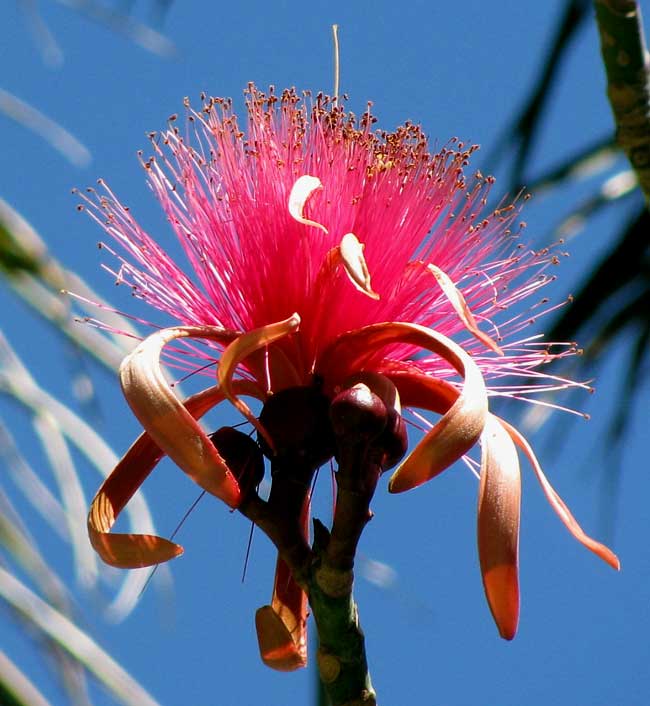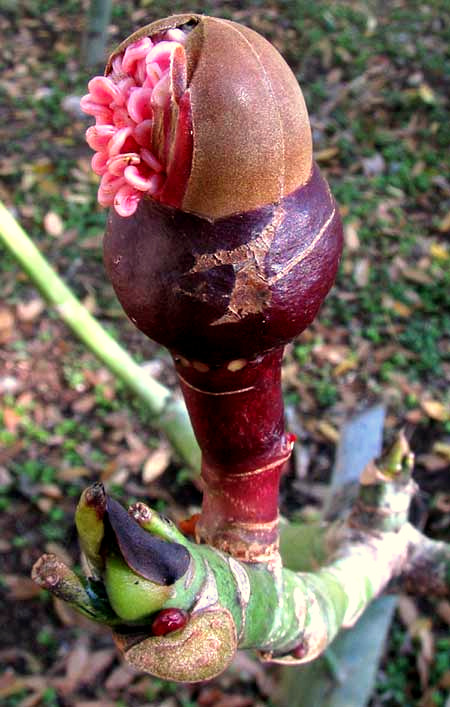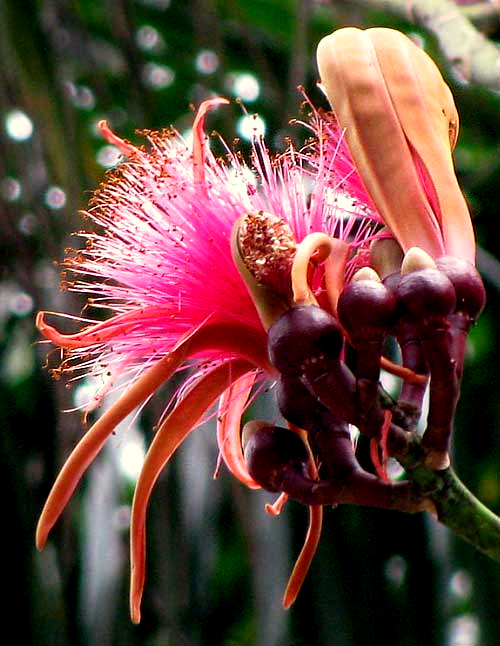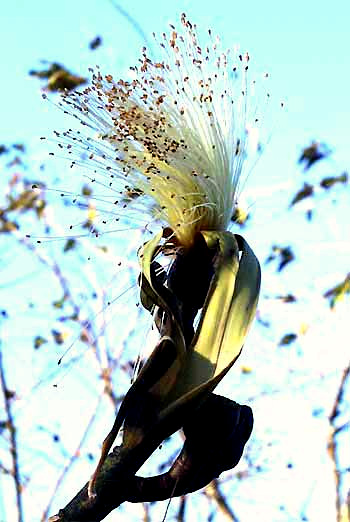Excerpts from Jim Conrad's
Naturalist Newsletter

from the February 14, 2010 Newsletter issued from Hacienda Chichen Resort beside Chichén Itzá Ruins, central Yucatán, MÉXICO
BOMBAX/ AMAPOLA/ SHAVINGBRUSH TREE
I've been waiting for a long time for a certain tree to bloom. When I got here in October the 20-ft-tall tree was green with digitally compound leaves (leaves arising from the petiole's top like digits from a hand), but now it's completely leafless. There's just a rather gangly looking naked tree with thick, pale gray, semisucculent branches, and at the end of many branches are clustered buds.
And those buds are substantial. Look at the one below:

That bud is two inches tall (5 cm). As immature flower parts inside the bud expand before blossoming a brown bud-scale has fallen off revealing pink anthers filled with immature pollen grains.

Above you see what happens next. If the bud scales aren't shed early (they often are) the scales lengthen into the long, pinkish-tan, petal-like items seen on the mostly unopened flower at the right. They are about four inches long (10 cm). You can see a single open flower with its hundreds of pink male stamens and its single stigma-tipped female style emerging from among them in the picture at the top of the page.
Throughout southern Mexico this is called the Amapola, though that's a name applied to several species. In Maya this tree is Chak Kuyché, and it's even planted enough in English-speaking lands for it to have an English name, which is, somewhat predictably, Shavingbrush-tree. It's PSEUDOBOMBAX ELLIPTICUM. I've always known it as belonging to its own family, the Bombax Family or Bomacaceae, but recently that family has been sunk into the Hibiscus Family, the Malvaceae, along with the Linden or Basswood Family (Tiliaceae) and the Chocolate Family (Sterculiaceae).
This gorgeous species is native to our area -- southern Mexico south to Honduras and El Salvador, and is grown as an ornamental in Florida, Hawaii and other semitropical parts o the world. It can reach 60 feet high (18 m).
In Las Plantas Medicinales de México I read that the flowers can be cooked to make a tea for feavers and coughs, and the powdered bark can tighten the gums.
from the February 18, 2006 Newsletter issued from Hacienda San Juan near Pueblo Telchacl Yucatán, MÉXICO
BOMBAX/ AMAPOLA/ SHAVINGBRUSH TREE
At the back of the hacienda there's a 15-ft-tall tree somewhat homely with its stubby, stiff branches and dry-season leaflessness. The tree's smooth, gray bark reminds you of saggy elephant hide. There's little symmetry about the tree. Mostly the tree is just a tangle of blunt stems leading off in every direction and set atop a fat, gray trunk.
However, as with everything in nature I have ever seen, no matter how plain it looks most of the time, always there's a certain perspective one can take, or a perfect time for visiting, during which the thing shines with such beauty that one just has to stand and admire.
The ugly tree's time is now, for it is flowering, and those flowers are something to see. Set at the end of thick, leafless branches and looking like bright shaving-brushes on long, gnarly handles, the flowers are about six inches long. The flowers' shaving-brush- like "bristles" consist of about 400 pollen-producing stamens and one stigma-bearing style, all slender, stiff and white. That's the blossom below:

In English sometimes it's called the Shaving Brush Tree. In Maya it's called Amapolo. In the Nahuatl spoken by the ancient Aztecs and still used in much of central Mexico it's Xiloxóchitl, which means "Cornsilk Flower." Sometimes in Spanish it's called Cabellos de Ángel, which means "Angel Hair." Both these last names refer to the blossom's abundant long stamens. The tree's Latin name is BOMBAX ELLIPTICUM, and it's a member of the tropical Bombax Family, so it's related to the kapok producing Ceiba I told you about a while back.
Visiting the tree not long after dawn as the day's first sunlight slanted in from the east, the Amapola's unopened flowers looked like long, slender, brown, cigars. The brownness was contributed by the flowers' long, slender petals, which were brown on the outside and slightly connected to one another along their margins. Instead of the petals separating from another from their tips, first they would buckle outward at their bases and slits would appear between the petals around the base of the "brown cigar."
Thus as I arrived two overwintering Hooded Orioles, gorgeously orange and black against the dark blue sky, were busily flitting from opening flowering to opening flower sticking their bills into the vertical slits at the flowers' bases, sipping nectar.
And those birds must have been rewarded with copious nectar, for I could see how vigorously their throat muscles worked as their bills poked through the slits. I also saw how glistening beads of nectar clung to the birds' withdrawn beaks, and how the birds themselves peed as frequently as sapsuckers at sap-rising time up North.
As time passed the flower petals split from one another irregularly, with some remaining joined to their adjacent petals and others coming undone completely, but eventually every flower had its tuft of stamens and style completely unsheathed. In the picture you can see that the two petals nearest the camera are still united, except for the slit between their bases.
The open blossoms attracted not only Hooded Orioles but also honeybees, but the bees seemed to be mostly or entirely interested not in the nectar at the base of the many long stamens but in the pollen at the tips of the stamens. It was nothing to see an oriole probing deeply into the stamen tuft while six to ten bees worked the same flower's stamen tips.
All these sweet, lush bouquets in a brown, dry-season- parched landscape attracted beetles, flies, gnats and more. Sometimes the orioles would catch an insect and gobble it down while hardly missing a beat rushing from opening flower to flower. Nor were orioles the only birds. A Least Flycatcher was kept busy and I could hear his tiny beak snapping sharply upon insects too small to show through my binoculars. Even an uncommon, endemic Yucatan Woodpecker passed through, though he seemed more interested in peripherally participating in the communal commotion than in accepting anything the Amapola directly offered.
In an old botany book found moldering in the hacienda's library I read that in the Mexican state of Veracruz a tea of Amapola flowers is used against fevers and coughs. A decoction of the tree's bark and root is used for toothache and strengthening the gums. The flowers are often gathered for decorations in churches, and some Mexicans say it is as pretty as any flower they know.